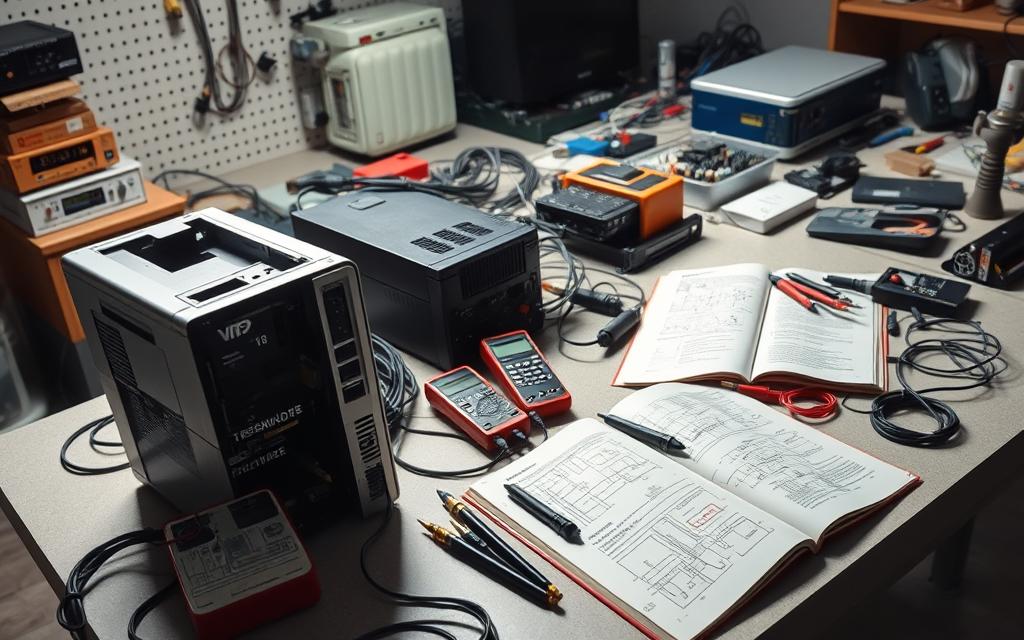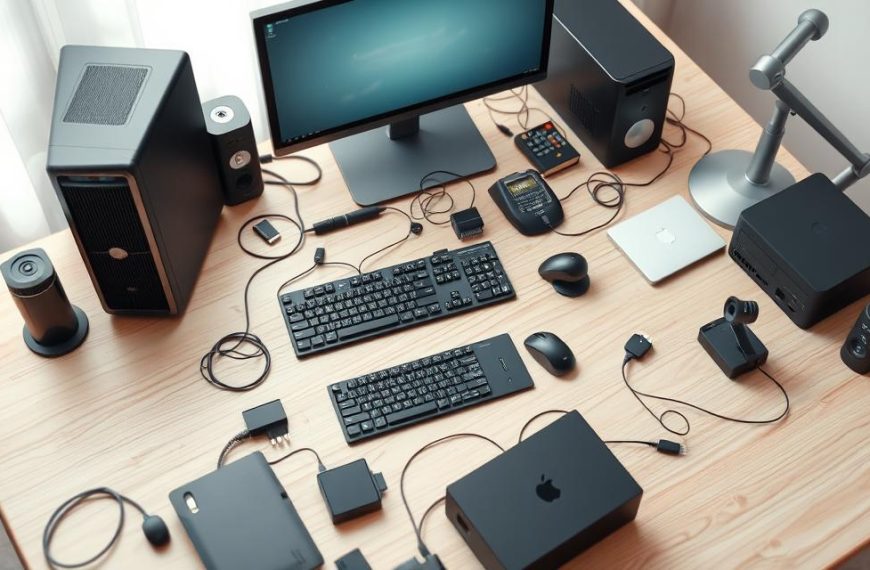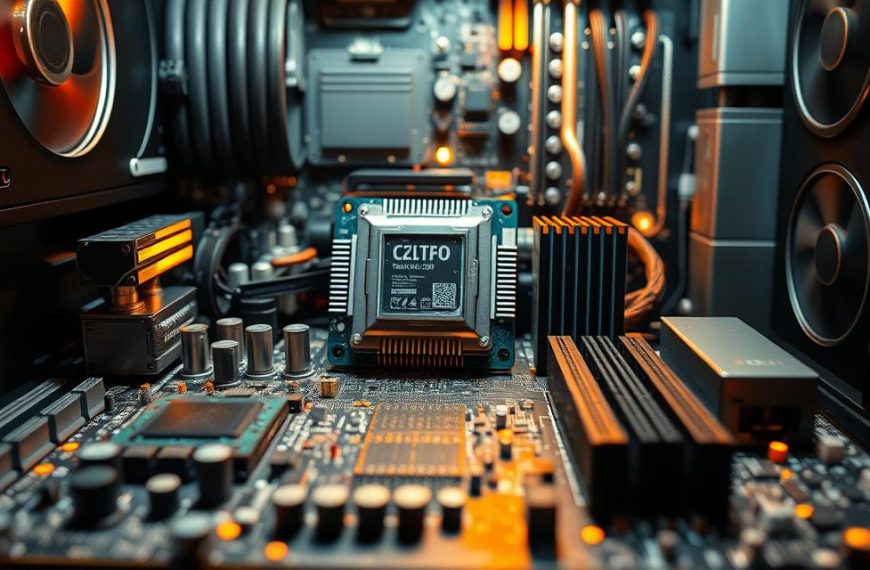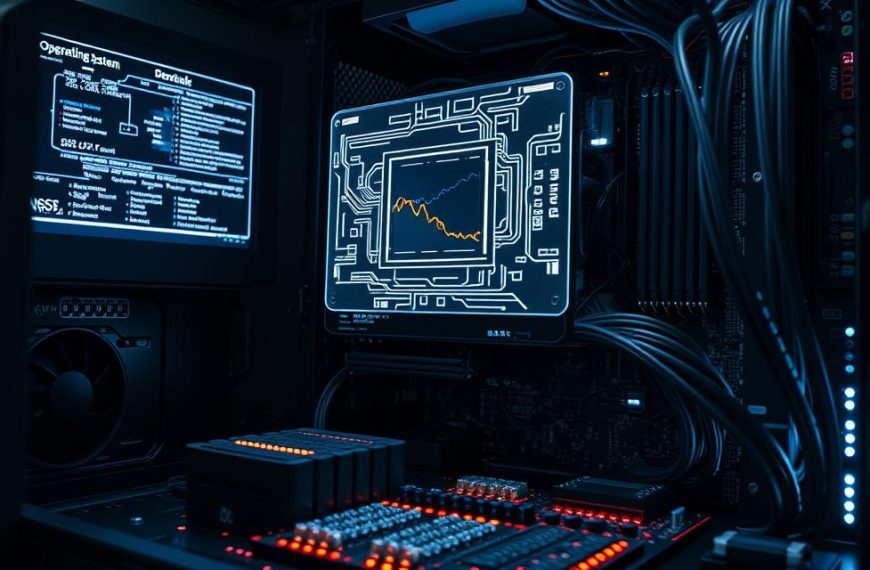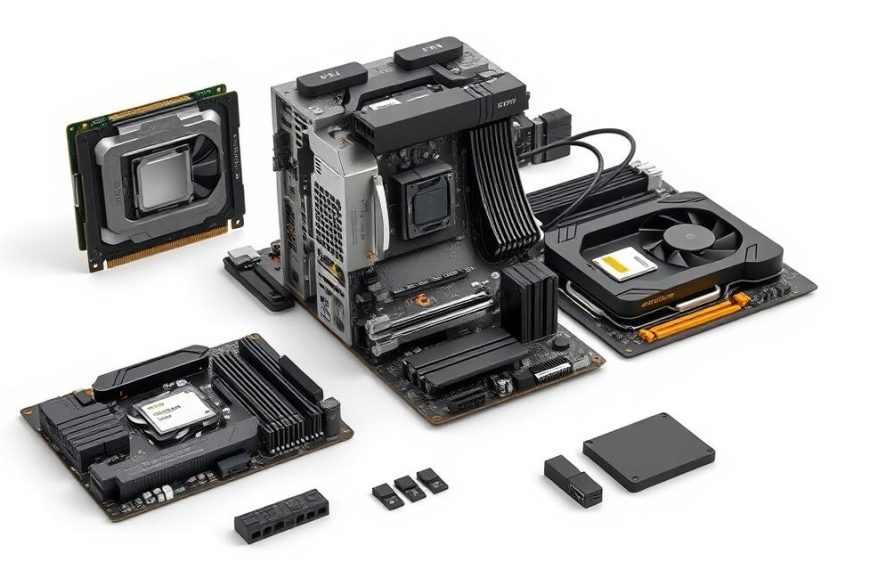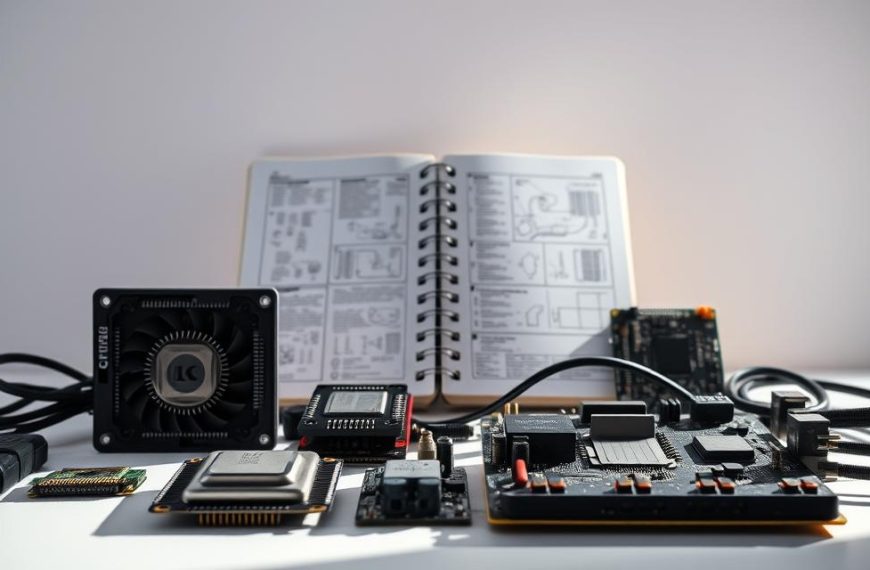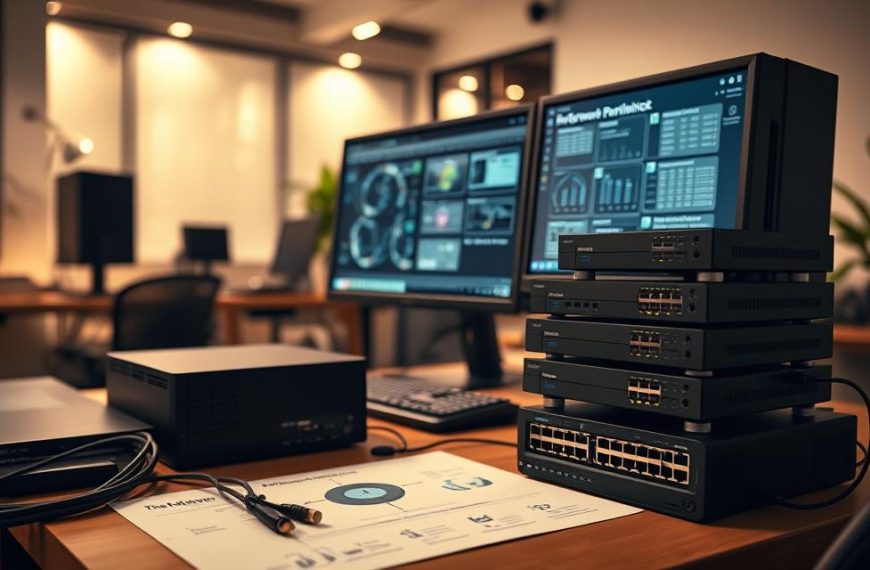Modern computers sometimes face hardware challenges. Knowing about these issues can save time and money. Early detection is vital for keeping your system running smoothly.
Hardware problems can cause system failures or slow performance. Users might see frozen screens or sudden shutdowns. Common issues include startup failures, memory shortages, and unexpected crashes1.
GPUs, hard drives, SSDs, RAM, power supplies, and fans often fail first. CPUs are usually the most reliable part. Regular upkeep can greatly reduce hardware failures21.
Good troubleshooting means knowing the warning signs. It also involves using the right diagnostic tools. Windows offers built-in tools like Performance Monitor and Memory Diagnostic2.
These tools can quickly scan your system. They provide insights into potential problems. Regular maintenance helps avoid costly repairs.
Cleaning computer parts, especially fans, keeps the system healthy. Taking care of your computer can extend its life and performance2.
Understanding Basic Computer Hardware Components
Computer components form the backbone of modern digital systems. Each hardware element plays a vital role in ensuring smooth performance. Understanding these components helps users diagnose issues and make informed decisions about system upkeep.
The motherboard is the central hub for all computer hardware components. When damaged, it can disrupt the entire system’s functionality. Modern computers consist of several key components that work together.
Essential Components Overview
- Central Processing Unit (CPU)
- Random Access Memory (RAM)
- Storage Drives
- Graphics Card
- Power Supply Unit (PSU)
Role of Each Component in System Performance
CPUs are the computational powerhouses of computer systems. Modern processors contain billions of transistors, enabling high-speed data processing3. The number of CPU cores impacts multitasking capabilities.
Processors with 8 cores handle more simultaneous processes than 2-core alternatives4. This allows for smoother operation when running multiple applications.
| Component | Performance Impact |
|---|---|
| CPU | Processes computational tasks |
| RAM | Enables simultaneous data handling |
| Storage | Stores and retrieves data |
Common Hardware Failure Points
Hardware performance can be compromised by various system failure points. Power supply failures account for about 30% of computer hardware malfunctions4.
Faulty RAM can dramatically reduce operational speed. It can potentially decrease system performance by up to 50%4.
Proactive maintenance and understanding of hardware components are crucial for optimal computer performance.
Power Supply and Boot-up Issues
Computer boot-up issues often stem from power supply problems. Understanding these challenges is crucial for effective PSU troubleshooting5. Many PC boot problems arise from improper power connections.
Users often overlook basic power cable checks5. Diagnostic procedures can help pinpoint the source of boot-up difficulties.
Comprehensive hardware diagnostics reveal various system failure symptoms during boot-up. These can include complete system non-response, spontaneous restarts, and unexpected system lockouts6.
- Complete system non-response
- Spontaneous restarts
- Unexpected system lockouts6
Power supply issues show specific warning signs. Case fans and hard drives failing to spin can indicate PSU malfunctions6. Recurring Blue Screen of Death errors might also signal power supply problems6.
| Diagnostic Method | Purpose |
|---|---|
| Paper Clip Test | Identify short circuits and component failures6 |
| Multimeter Testing | Measure voltage, current, and resistance6 |
Experts suggest strategies for addressing power supply problems. Proactive testing and replacement can prevent more significant system failures. Most power supply units last 5 to 7 years5.
When troubleshooting, follow these key steps:
1. Check all power cable connections
2. Test the power supply unit
3. Verify system component connections
4. Seek professional help if issues persist
How to Detect Computer Hardware Problems
Computer hardware diagnostics are vital for keeping your system running smoothly. Spotting early signs of hardware failure can prevent system breakdowns. Regular maintenance can stop 80% of potential hardware issues from becoming major problems7.
Recognising Warning Signs
Early detection of hardware problems requires watching system performance closely. Look out for these key warning signs:
- Unexpected system freezes or crashes
- Strange noises from internal components
- Slow performance or unresponsive applications
- Frequent Blue Screen of Death (BSOD) errors
About 30% of users report slow performance as a common hardware issue symptom7. Odd noises like clicking or grinding can signal a failing hard drive or fan.
Using Diagnostic Tools
Specialised tools make monitoring system performance more effective. These tools can spot hardware errors with 70% success rate7. Here are some recommended tools:
- Windows Memory Diagnostic for memory checks
- SMART status tools for hard drive health
- CPU and GPU stress testing utilities
SMART status tools can predict hard drive failures with over 90% accuracy7. BSOD errors happen in about 10% of system crashes, often due to hardware failures7.
System Performance Indicators
Checking system logs can reveal hardware-related errors in 60% of systems with performance issues7. Key indicators include:
- CPU and GPU temperature
- Memory usage
- Disk read/write speeds
- Power supply voltage stability
Getting professional help can cut repair times by half compared to DIY methods7. Stay alert and use proper diagnostic tools to keep your computer healthy.
Storage and Memory Troubleshooting
Computer storage and memory are vital for smooth system performance. Issues with these components can disrupt your digital tasks. Addressing problems promptly helps maintain your computer’s efficiency.
Spotting storage device issues is crucial. RAM problems can show up in various ways:
Regular cleaning prevents 25% of hardware issues caused by dust. Proper handling reduces electrostatic discharge failures by 70%8. These simple steps can significantly extend your hardware’s life.
Diagnostic tools are essential for identifying potential problems. Windows Memory Diagnostic and MemTest86 detect RAM issues with over 90% accuracy8. These tools help users address memory problems before they worsen.
Upgrading RAM can boost system performance by 20-30%8. Compatibility checks are vital, as mismatched RAM causes installation failures in half the cases8.
Tech-savvy users can fix many storage and memory problems themselves. This approach cuts the need for professional help by 40%8. Regular updates and careful handling are key to maintaining system health.
Cooling System and Temperature Management
Computer overheating is a major issue for modern technology users. Powerful processors and compact devices make effective temperature management crucial. Proper cooling system maintenance is essential for optimal computer performance9.
Preventing overheating requires a strategic approach to cooling system upkeep. Knowing the signs and taking proactive steps can extend your device’s life. It can also improve its overall performance10.
Recognising Overheating Warning Signs
- Unexpected system shutdowns9
- Unusual fan noises10
- Performance lag or stuttering10
- Excessive heat when touching the device10
Preventive Maintenance Techniques
- Regularly clean computer components to remove dust9
- Check and reapply thermal paste periodically9
- Ensure proper cable management for optimal airflow9
- Position computers away from obstructions9
Advanced Cooling Solutions
For effective temperature management, consider these upgrades:
| Cooling Solution | Effectiveness |
|---|---|
| Cooling Pads | Enhanced laptop ventilation9 |
| Additional Case Fans | Improved airflow10 |
| Liquid Cooling Systems | Superior heat dissipation10 |
Proactive cooling system maintenance is vital for preventing hardware damage. It also helps maintain optimal computer performance. Regular upkeep ensures your device runs smoothly and efficiently910.
Display and Peripheral Device Issues
Monitor and input device problems can disrupt computer functionality. Peripheral device troubleshooting needs a systematic approach. Computers depend on external devices for interaction and performance11.
Peripheral devices include input, output, and storage components. These often face technical challenges. Wired connections have port issues in 30% of troubleshooting cases11.
Wireless peripherals face Bluetooth and Wi-Fi interference in 25% of instances11. Diagnostic strategies can solve many peripheral device challenges. Testing devices on other computers fixes 40% of issues11.
Updating device drivers is crucial. Outdated software causes 20% of peripheral-related problems12. Uninstalling and reinstalling devices solves 40% of complications, especially for webcams and printers12.
Preventative maintenance includes regular driver updates and firmware management. Compatibility checks are also important. Access control measures can reduce unauthorised access by 40%11.
These strategies help users manage and troubleshoot peripheral devices effectively. Understanding them empowers users to handle device interactions confidently.
FAQ
What are the most common computer hardware components I should be aware of?
How can I tell if my computer’s power supply is failing?
What diagnostic tools can I use to check my computer’s hardware health?
How do I recognise signs of storage device failure?
What causes computer overheating, and how can I prevent it?
How can I troubleshoot display and peripheral device issues?
What should I do if my computer won’t boot up?
How often should I perform hardware maintenance?
What are the best ways to upgrade computer memory?
How can I protect my computer from hardware failures?
Source Links
- https://www.pluralsight.com/resources/blog/guides/troubleshooting-hardware
- https://www.makeuseof.com/tag/how-to-test-your-pc-for-failing-hardware/
- https://www.downtowncomputers.com/understanding-computer-hardware-a-beginners-guide/
- https://computercare.net/blog/understanding-computer-hardware/
- https://www.digitaltrends.com/computing/pc-troubleshooting-guide/
- https://www.neweggbusiness.com/smartbuyer/components/how-to-troubleshoot-a-pc-power-supply/
- https://www.docphonefix.com/how-to-diagnose-common-computer-hardware-issues
- https://www.ituonline.com/blogs/ram-memory-issues/
- https://dr-it.co.uk/detecting-failing-pc-cooling-a-how-to-guide/?srsltid=AfmBOoqJL3wzmcVLfO_sns6GkvznKyzD9tOUM52RO1VbMg2eIMFaku0o
- https://www.ituonline.com/blogs/troubleshoot-computer-hardware-problems-computer-overheating/
- https://itfix.org.uk/troubleshoot-and-fix-peripheral-device-issues/
- https://www.popsci.com/diy/fix-keyboard-mouse-printer-headphones-scanner/

